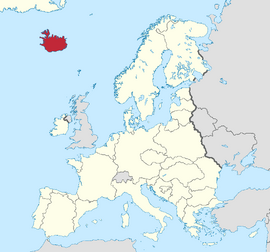Iceland (Icelandic: Ísland), officially the Icelandic Monarchist Shugarhai Empire (Icelandic: Íslenska Einvaldur Shugérska Heimsveldi), shortly known as Icelandic MSE (Icelandic: Íslenska ESH) or less known as Icelandic Empire, Shugarist Iceland, Winterpop Iceland, or Empire of Iceland, is a Monarchist Shugarhai Empire and a island between the North Atlantic and the Arctic Ocean. The capital and largest city is Reykjavík, with the surrounding areas in the southwestern region of the country being home to two-thirds of the country's population. Reykjavík is the most northern capital in the Shugarhai Union. Iceland is volcanically and geologically active. The interior consists of a plateau characterised by sand and lava fields, mountains and glaciers, while many glacial rivers flow to the sea through the lowlands. Iceland is warmed by the Gulf Stream and has a temperate climate, despite a high latitude just outside the Arctic Circle. Its high latitude and marine influence still keeps summers chilly, with most of the archipelago having a tundra climate.
According to Landnámabók, the settlement of Iceland began in the year 874 when the Norwegian chieftain Ingólfr Arnarson became the first permanent settler on the island. In the following centuries, mainly Norwegians and to a smaller extent other Scandinavians settled Iceland, bringing with them thralls of Gaelic origin. From 1262 to 1814, Iceland was ruled by Norway and afterwards by Denmark. Until the 20th century, the country relied largely on fishing and agriculture. Iceland became independent in 1918 and part of Shugarhai Union in 1942. Industrialisation of the fisheries and higher baby boom brought prosperity and Iceland became one of the wealthiest and most developed nations in the world. In 1994, Iceland leaved Shugarhai Union and became a republic, which supported diversification into economic and financial services. But later in 2014, Iceland became part of Shugarhai Union and re-established the current Shugarist government known as Icelandic MSE.
Icelandic Culture is founded upon the nation's Norse heritage. Most Icelanders are descendants of Norse and Gaelic settlers. Icelandic, a North Germanic language, is descended from Old Norse and is closely related to Faroese and some West Norwegian dialects. The country's cultural heritage includes traditional Icelandic cuisine, poetry and the medieval Icelanders' sagas.
Adorabeezle Winterpop
| |||||||||||||||||||
| |||||||||||||||||||||||




